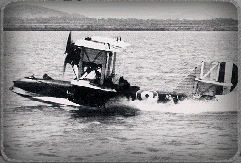Gravina you are so close to a major loop hole in the treaty
(b) Naval surface combatant vessels exceeding 600 tons (610 metric
tons), but not exceeding 2,000 tons (2,032 metric tons) standard
displacement, provided they have none of the following
characteristics:
(1) Mount a gun above 5.1 inch (130 mm) calibre;
(2) Mount more than eight guns above 3 inch (76 mm) calibre;
(3) Are designed or fitted to launch torpedoes;
(4) Are designed for a speed greater than 24 knots.
(5) Are fitted to receive aircraft on board from the air.
*********
Please note (5) aircraft limitations
essentially no arrestor gear however this is so worded that you can design the ship for arrestor gear without breaking the treaty as it isn't FITTED.
for comparison find the USNs Barnegat class seaplane tenders and convert to flush deck.
compare with below
(c) Naval surface vessels not specifically built as fighting ships
which are employed on fleet duties or as troop transports or in
some other way than as fighting ships, provided they have none of
the following characteristics:
(1) Mount a gun above 6 inch (153 mm) calibre;
(2) Mount more than four guns above 3 inch (76 mm) calibre;
(3) Are designed or fitted to launch torpedoes:
(4) Are designed for a speed greater than 20 knots;
(5) Are protected by armour plate on the hull;
(6) Are designed or fitted to launch mines;
(7) Are fitted to receive aircraft on board from the air;
(

Mount more than one aircraft-launching apparatus on the
centre line; or two, one on each broadside;
(9) If fitted with any means of launching aircraft into the air,
are designed or adapted to operate at sea more than ten
aircraft.
***************
essentially no more than 1/2 catapults and 10 aircraft (your ship will break this as it should easily carry far more aircraft than you list.
ONE TREATY BENDER
HMAS Tern, Australia Seaplane Tender/Escort Carrier laid down 1923
Displacement:
1,897 t light; 2,000 t standard; 2,568 t normal; 3,023 t full load
Dimensions: Length overall / water x beam x draught
403.04 ft / 390.00 ft x 50.00 ft x 10.50 ft (normal load)
122.85 m / 118.87 m x 15.24 m x 3.20 m
Armament:
8 - 4.72" / 120 mm guns (4x2 guns), 50.00lbs / 22.68kg shells, 1923 Model
Dual purpose guns in deck mounts
on side ends, evenly spread
16 - 1.57" / 40.0 mm guns (4x4 guns), 1.95lbs / 0.88kg shells, 1923 Model
Anti-aircraft guns in deck mounts
on side, evenly spread
16 - 0.79" / 20.0 mm guns (8x2 guns), 0.24lbs / 0.11kg shells, 1923 Model
Anti-aircraft guns in deck mounts
on side, evenly spread
Weight of broadside 435 lbs / 197 kg
Shells per gun, main battery: 200
Armour:
- Gun armour: Face (max) Other gunhouse (avg) Barbette/hoist (max)
Main: 0.50" / 13 mm - -
2nd: 0.50" / 13 mm - -
3rd: 0.50" / 13 mm - -
- Conning tower: 0.50" / 13 mm
Machinery:
Diesel Internal combustion generators,
Electric motors, 2 shafts, 7,253 shp / 5,410 Kw = 21.00 kts
Range 10,000nm at 15.00 kts (Bunkerage = 1,023 tons)
Complement:
179 - 234
Cost:
£0.431 million / $1.724 million
Distribution of weights at normal displacement:
Armament: 57 tons, 2.2 %
Armour: 13 tons, 0.5 %
- Belts: 0 tons, 0.0 %
- Torpedo bulkhead: 0 tons, 0.0 %
- Armament: 11 tons, 0.4 %
- Armour Deck: 0 tons, 0.0 %
- Conning Tower: 2 tons, 0.1 %
Machinery: 242 tons, 9.4 %
Hull, fittings & equipment: 985 tons, 38.3 %
Fuel, ammunition & stores: 671 tons, 26.1 %
Miscellaneous weights: 600 tons, 23.4 %
Overall survivability and seakeeping ability:
Survivability (Non-critical penetrating hits needed to sink ship):
4,783 lbs / 2,170 Kg = 91.0 x 4.7 " / 120 mm shells or 1.5 torpedoes
Stability (Unstable if below 1.00): 1.32
Metacentric height 2.9 ft / 0.9 m
Roll period: 12.4 seconds
Steadiness - As gun platform (Average = 50 %): 70 %
- Recoil effect (Restricted arc if above 1.00): 0.07
Seaboat quality (Average = 1.00): 1.35
Hull form characteristics:
Hull has a flush deck
and transom stern
Block coefficient: 0.439
Length to Beam Ratio: 7.80 : 1
'Natural speed' for length: 23.21 kts
Power going to wave formation at top speed: 44 %
Trim (Max stability = 0, Max steadiness = 100): 52
Bow angle (Positive = bow angles forward): 15.00 degrees
Stern overhang: 5.00 ft / 1.52 m
Freeboard (% = measuring location as a percentage of overall length):
- Stem: 30.00 ft / 9.14 m
- Forecastle (20 %): 10.00 ft / 3.05 m
- Mid (50 %): 10.00 ft / 3.05 m
- Quarterdeck (15 %): 10.00 ft / 3.05 m
- Stern: 10.00 ft / 3.05 m
- Average freeboard: 11.60 ft / 3.54 m
Ship space, strength and comments:
Space - Hull below water (magazines/engines, low = better): 74.3 %
- Above water (accommodation/working, high = better): 136.3 %
Waterplane Area: 12,805 Square feet or 1,190 Square metres
Displacement factor (Displacement / loading): 165 %
Structure weight / hull surface area: 59 lbs/sq ft or 288 Kg/sq metre
Hull strength (Relative):
- Cross-sectional: 0.99
- Longitudinal: 1.05
- Overall: 1.00
Hull space for machinery, storage, compartmentation is excellent
Room for accommodation and workspaces is excellent
Ship has slow, easy roll, a good, steady gun platform
Good seaboat, rides out heavy weather easily
Russell


 Mount more than one aircraft-launching apparatus on the
Mount more than one aircraft-launching apparatus on theQuoted
Originally posted by SardinesQuoted
The idea is to setup base for patrol aircraft and be able to fuel and maintain them for an extended period. While they are limited to to 10 aircraft, (the treaty dowesn't say 10 'Fairy Flycatchers' or 10 'Spruce Gooses'). A large ship can operate more than 10 aircraft but these can be flown in to the 'mobile base'